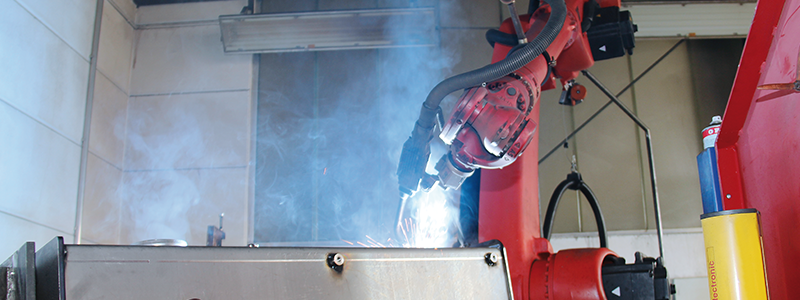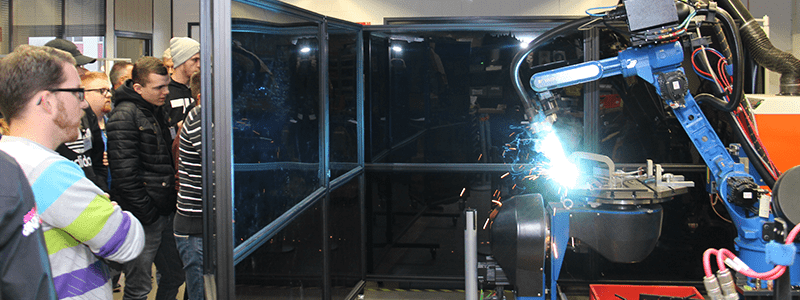When I used to teach robotic welding misconceptions, I used to try to clear up to people:
Spatter is weld wire.
Many manufacturing engineers are under the impression that spatter is the puddle exploding. That is true to a point, but where the misconception often comes in play is the thinking that the source of spatter is the base metal, which it is not. Really, spatter comes from the filter metal.
If you have spatter on your parts, the problems associated with that are expensive and permeate the business:
- Anytime you see weld berries or spatter, it's money on the floor. Spatter is literally your weld wire blowing out and throwing equipment spend on the floor or on the part to grind out.
- If weld anything with studs or threaded studs, spatter becomes a big issue to your metal fabrication. Whether it's an external male thread or a female thread, it's a difficult problem to deal with because it makes connecting other parts to the piece more time consuming and difficult.
- Spatter affects downstream production and equipment reputation when you are completing a welded piece of equipment.
/ABIBLOG%20BRASIL/7%20most%20common%20Welding%20Defects%20and%20how%20to%20solve%20them/blog_welding_defects_spatter_01.png?width=283&name=blog_welding_defects_spatter_01.png)
A worst-case example of weld spatter impacting a manufacturing business would be if you have weld spatter on a car part. If a part has spatter, and you paint the part, and then a year from now that spatter breaks off when an operator is driving a car down the highway, it breaks off with the paint, as well.
Now rust collects inside underneath the paint whenever the car gets wet. This means that part of the car breaks off or rusts out faster, reputations take a hit, and demand dwindles.
There’s an entire downstream effect to accepting or overlooking spatter on a welded part.
Controlling spatter also saves you from spending on grinding disks and manpower and prevents degradation on your parts.
Think about it: every time you touch a part, it is cost.
The least amount that you have to pay to touch that part, the more economical you're going to be.
What Causes Weld Spatter?
Weld settings is usually the root cause of most spatter issues for metal fabricators. Usually if you're running a mild steel welding operation, weld spatter is caused by either poor wire or too cold of gas or your weld was too cold to begin with.
If your voltage is too low, you're going to get a lot of spatter.
Even if you run a hotter shielding gas and even if you're well-defined, a lot of times you will eat up your voltage and wet that out a little bit more.

Does Pulse or Short Arc Cause More Spatter?
Normally short arc is going to give you more spatter issues because of the process. Pulse is a much cleaner and faster welding process.
However, you can only weld so thin with pulse so there's a fine line with that process.
If you're running 100% CO2, you're going to get a better dig out of your weld you'll get better penetration, but you're also going to end up with a lot more spatter.
CO2 gas creates a more volatile arc. This is one reason many manufacturers use an argon CO2 mix, which is heavy on the argon and helps avoid spatter issues.
Spatter from Metal Contamination
Aside from gas mixture and weld process, metal contamination will be second biggest source of spatter.
The same factors that may cause you porosity will also be a source of spattering. Things like oil on parts, mill scale, and part coating.
You can run a clean process with a clean gas mix and quality wire, but if you are welding on galvanized or any highly contaminated material, the spatter is going to compound.
The same goes for other types of coatings, but a galvanized material like Zinc is probably the most common that you'll see out in production that you'll have to weld through.
Incorrect Robot Program
For robotic, one of the biggest causers of spatter for robotic welding processes is an incorrect robot program. Normally that’s as simple as the travel speed of the robot being too fast for the rate of deposition.
You can only melt and lay metal down so fast before physics says no. Think of robotic welding as plowing snow.

When you plow snow at 90 miles per hour, snow flies off everywhere and doesn’t settle in a clean formation as opposed to when snow is plowed at 10 miles per hour. That’s a similar scenario with a robotic weld program, and one of the ways to avoid excessive spattering is by not overcompensating on the program speed.
Contact Tip to Work Distance
Another thing that contributes to spatter as well is electrical stick out, or tip to work distance. Having this setting incorrect on your welding torch perpetuates other issues within the welding process aside from spatter.
For spattering in particular, if that tip gets too far away from the part, it's going to give you a bunch of issues.
While some welding power supplies like synergistic machines can help compensate for a slight tip to work distance disparity, going from 5/8 inch stick out to 1 ½ inch stick out can’t be overcome by a weld machine. Not to mention weld quality will drop dramatically.
Whether you are too far or too close to the weld, the same spatter issues can arise from a tip to work distance problem.
Unfortunately, there’s no perfect number for a correct tip to work distance on your welding process. It’s going to come down to your consumables, your welding wire, and your gas type to find the right number that limits spatter.
Push Angle of the Welding Torch
Another cause of spatter on your process is the push angle of the torch. If the angle is too extreme – usually this happens with a robotic weld program, your welding torch get a plowing effect on the part and produces excessive spatter. Ideally, you want to keep your torch angle around 12 to 15 degrees of push.
Keep in mind that push angle and work angle are two different things when talking about weld process:
- Work angle is the perpendicular direction to the work piece
- Push angle is the angle of the torch to the part while striking an arc
If your angle of your torch is too extreme, you have the same plowing effect. In my career, I’ve tended to keep the travel angle under 12 to 15 degrees of push. Travel angle is the amount of push or pull on the torch.
Shielding Gas Correcting Spatter Problems
We’ve covered most of the spattering conditions and how to avoid it. There's one more way spatter happens on your weld that you can reduce, and it has to do with your shielding gas coverage.
Changing gas coverage from a spread spectrum to a focus spectrum can help limit spatter and control chaos in the weld puddle. This especially can help if you run a hotter gas mix, say something in the 80/20 range.
Ideally, you want the weld puddle to be as clean and fluid as can be. How well you shielding gas covers the weld puddle will help reduce spatter. I have used this from an applications engineering standpoint many times with electronic gas management.
Welding gas is all about coverage; amount has little to do with the weld quality. Electronic gas regulators allow robotic torches to envelope the weld puddle, which will help protect against spatter and improve gas efficiency. The video below demonstrates how better coverage can protect against spatter. The left side has improved coverage, while the right side does not.
Electronic gas a management is especially useful if you are experience minor spatter build up where a cleaner envelope of shielding gas can improve the weld arc. You can utilize this method for stainless, galvanized, or mild steel applications.
It will not cure a significant spatter problem (although it will definitely improve it!), but even then being able to go from having to grind spatter off pieces to being able to wipe off would save real cost on grinder discs and labor.
Want more on robotic welding? Check out our Definitive Guide to Robotic Welding. This guide goes in-depth on robot torch construction, evaluation criteria, and how to assess your own robot torch setup to ensure you get the most out of your production. No form fills to read... just click and get started.


